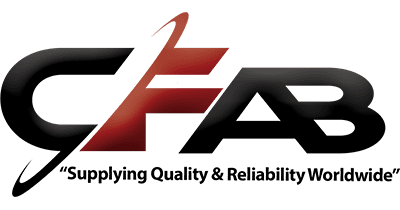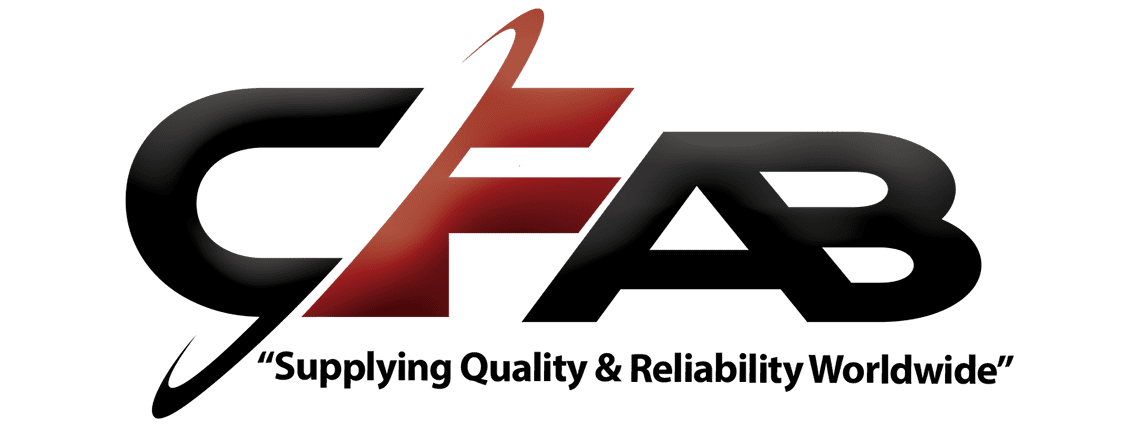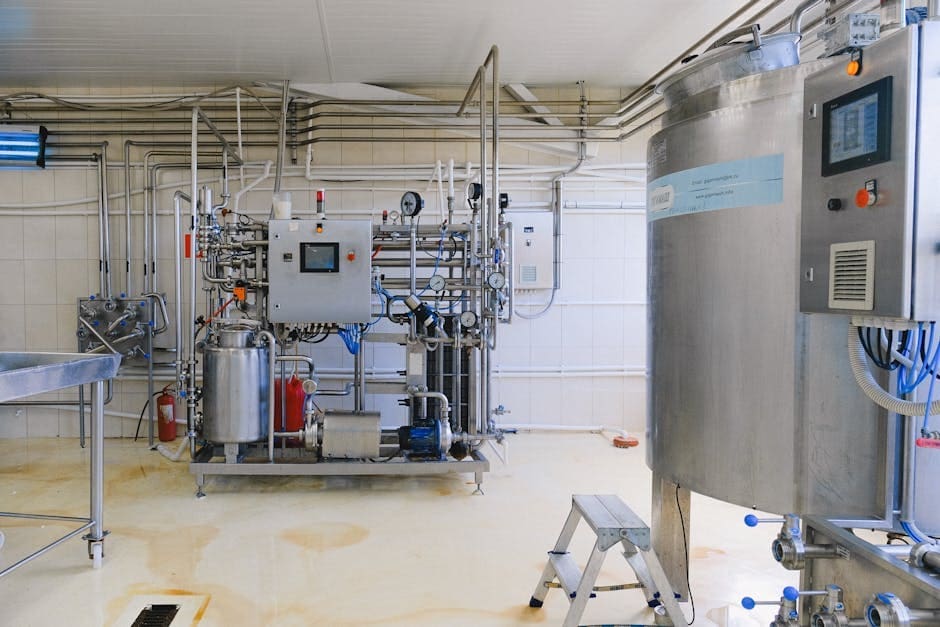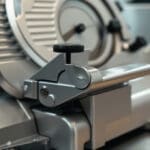What is OEE in manufacturing? It stands for Overall Equipment Effectiveness, a critical metric in manufacturing. OEE measures how well a manufacturing operation is used, focusing on its availability, performance, and quality. It’s a tool for determining hidden productivity losses —from machine breakdowns to slowdowns and defects—enabling companies to maximize their manufacturing potential.
- Availability: Ensures machines are running when they should be.
- Performance: Ensures machines are operating at optimal speeds.
- Quality: Ensures manufacturers produce good parts without defects.
In today’s ever-competitive landscape, many businesses are adopting lean manufacturing principles, with OEE at the forefront. By eliminating waste and enhancing efficiency, these businesses are not only increasing productivity but also staying ahead in the race toward Industry 4.0.
As Todd Cleppe, I have spent over 25 years in designing solutions that improve machinery performance across various industries, including manufacturing. Understanding what is OEE in manufacturing has allowed me to assist countless organizations in boosting their production efficiency and machinery lifespan.
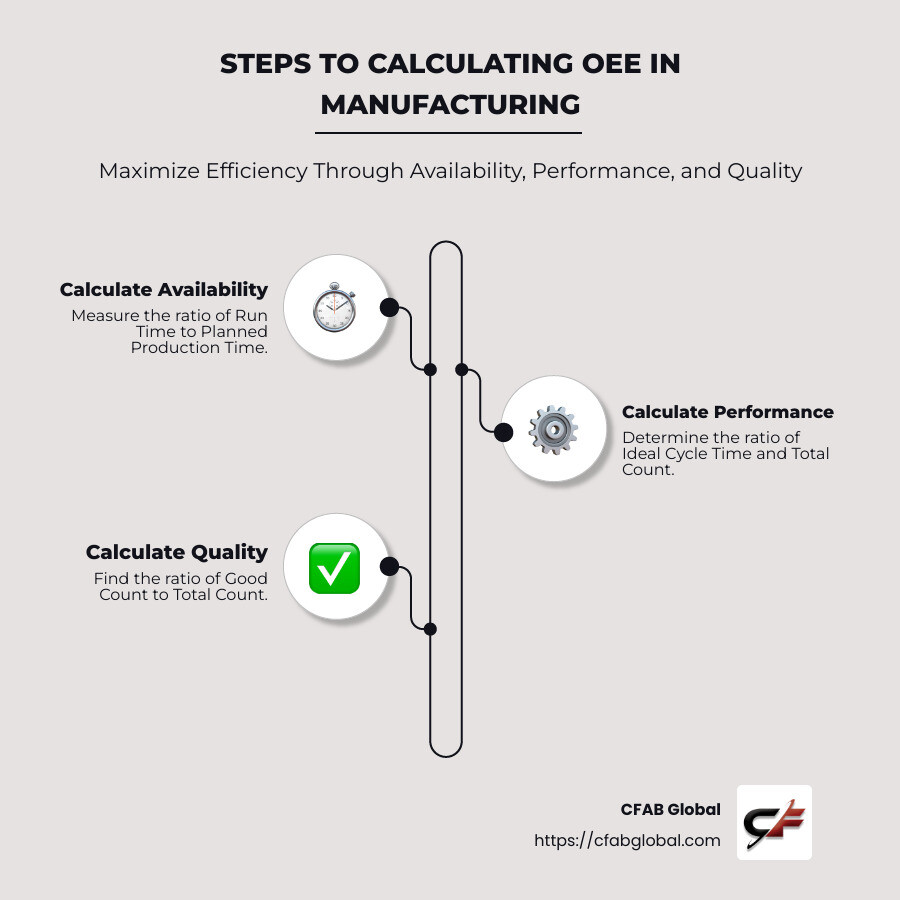
What is oee in manufacturing word guide:
– key performance metrics for manufacturing
– manufacturing efficiency
– industrial machinery efficiency
Understanding OEE in Manufacturing
To truly grasp what is OEE in manufacturing, we need to dive deeper into its components: Availability, Performance, and Quality. These three factors are central in identifying and reducing the Six Big Losses that plague manufacturing efficiency.
Availability
Availability measures the proportion of scheduled time that a machine is actually available for production. It accounts for both unplanned stops and planned stops.
-
Unplanned Stops: These are unexpected interruptions, like equipment breakdowns or sudden maintenance needs. For instance, a conveyor belt malfunction can halt production, leading to downtime. Addressing these stops requires proactive maintenance and quick response teams.
-
Planned Stops: These are scheduled events such as changeovers or routine maintenance. While they are necessary, minimizing their duration can significantly boost availability. Efficient planning and streamlined processes can help reduce these planned stops.
Performance
Performance evaluates whether equipment is running at its maximum speed. It considers slow cycles and small stops.
-
Slow Cycles: Occur when machines operate below their optimal speed. This can be due to worn-out equipment or incorrect settings. Regular equipment checks and proper training can mitigate these issues.
-
Small Stops: These are brief pauses, often under a minute, like minor jams or adjustments. Though short, they can add up. Training operators to swiftly handle these interruptions can help maintain a steady production pace.
Quality
Quality assesses the proportion of good parts produced without defects. It addresses issues like defects and rework.
-
Defects: These are products that don’t meet quality standards. Identifying and addressing root causes can prevent defects from recurring.
-
Rework: Involves correcting defective products, which consumes time and resources. Implementing robust quality control measures can reduce the need for rework, ensuring that products are right the first time.
By focusing on these components, manufacturers can identify inefficiencies and improve their operations. For example, a factory utilizing BE Machinery’s Automatic CIP Cleaning Systems can improve its availability by reducing cleaning downtime, improving its OEE score.
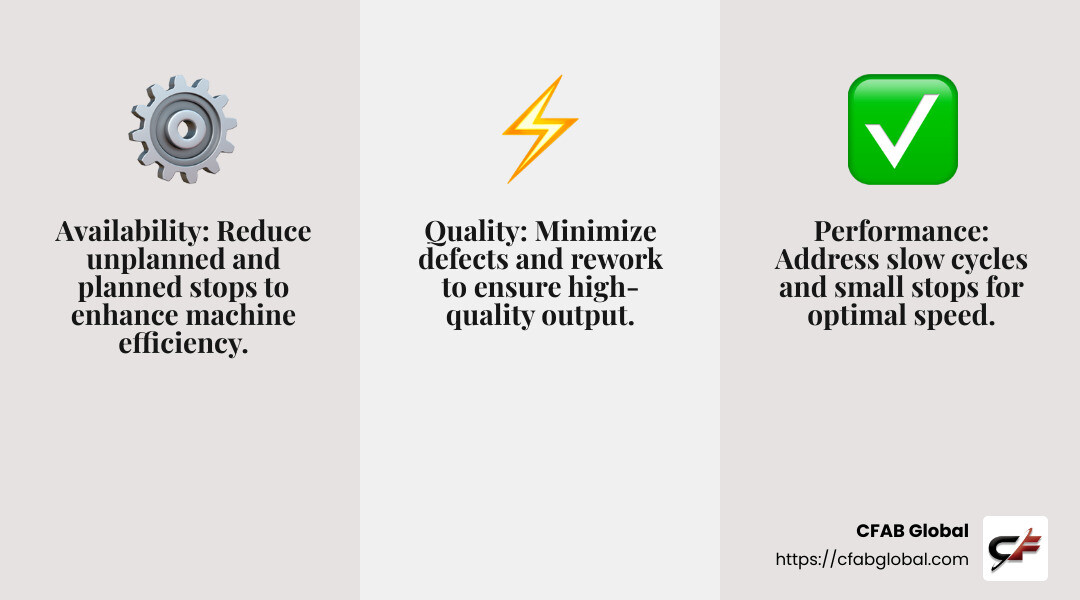
Understanding what is OEE in manufacturing and its components allows companies to pinpoint where they’re losing productivity and take actionable steps towards improvement. This foundation sets the stage for calculating OEE and implementing strategies for optimal manufacturing outcomes.
Calculating OEE for Optimal Manufacturing
To achieve optimal manufacturing results, calculating OEE (Overall Equipment Effectiveness) is essential. This calculation breaks down into three main components: Availability, Performance, and Quality. Let’s explore how each is calculated and contributes to the overall OEE.
OEE Formula
The formula to calculate OEE is straightforward:
OEE = Availability × Performance × Quality
This formula provides a comprehensive measure of manufacturing efficiency by capturing all potential losses.
Availability Calculation
Availability reflects the proportion of planned production time that is actually productive. It is calculated as:
Availability = Run Time / Planned Production Time
- Run Time is the actual time the equipment is operational, excluding any downtime from both planned and unplanned stops.
- Planned Production Time is the total time the equipment is scheduled to operate.
For instance, if a machine is scheduled to run for 8 hours (480 minutes) but experiences 60 minutes of downtime, the availability is calculated as:
[ \text{Availability} = \frac{(480 – 60)}{480} = 87.5\% ]
Performance Calculation
Performance examines if the equipment is working at its maximum speed. It’s calculated using:
Performance = (Ideal Cycle Time × Total Count) / Run Time
- Ideal Cycle Time is the fastest time to produce one unit under perfect conditions.
- Total Count is the total number of parts produced.
If the Ideal Cycle Time is 1.5 seconds per part and 240 parts are produced in 390 minutes, the performance is:
[ \text{Performance} = \frac{(1.5 \times 240)}{390} = 92.3\% ]
Quality Calculation
Quality measures the ratio of good parts produced to the total parts produced. It is calculated as:
Quality = Good Count / Total Count
- Good Count is the number of defect-free units produced.
- Total Count is the total number of units produced.
For example, if 240 units are produced and 20 are defective, the quality is:
[ \text{Quality} = \frac{(240 – 20)}{240} = 91.7\% ]
By understanding and calculating these components, manufacturers can better identify areas for improvement. For example, using BE Machinery’s Hygiene Rotary Filler & Capper can improve quality by ensuring consistent and contamination-free packaging.
Calculating OEE helps reveal the “hidden factory” of unused resources and production losses, setting the stage for further efficiency improvements.
Implementing OEE for Improved Efficiency
To truly harness the power of OEE, manufacturers must focus on benchmarking, fostering a culture of continuous improvement, and uncovering the “hidden factory” within their operations.
Benchmarking OEE
Benchmarking is about setting OEE targets that align with world-class standards. Aiming for an OEE score around 85% is often seen as reaching optimal capacity, a mark of high productivity.
-
World-Class OEE: This is the gold standard, where availability, performance, and quality are maximized. For many industries, achieving an OEE of 85% or higher indicates that the equipment is operating at its best.
-
OEE Targets: Setting realistic and strategic goals is essential. By analyzing production data and comparing it against industry benchmarks, companies can identify gaps and set attainable targets for improvement.
Continuous Improvement
A systematic approach is key to driving continuous improvement. This involves:
-
Production Data Analysis: Use data to identify trends, patterns, and areas needing attention. Advanced analytics can help pinpoint inefficiencies and guide decision-making.
-
Structured Improvement Initiatives: Implement programs like Kaizen or Lean manufacturing to foster a culture of ongoing improvement. Encouraging employee engagement and collaboration is vital for sustaining these efforts.
Hidden Factory
The concept of the “hidden factory” refers to the unused resources and production losses lurking within operations. Identifying these inefficiencies can open up significant potential:
-
Uncovering Hidden Resources: By visualizing and quantifying production losses, manufacturers can see what could be produced if all resources were optimized.
-
Reducing Production Losses: Addressing the six big losses in manufacturing—availability, performance, and quality losses—can lead to substantial gains. For instance, implementing BE Machinery’s advanced packaging solutions can help minimize downtime and improve quality.
By focusing on these areas, manufacturers can significantly improve their operational efficiency. This proactive approach not only improves current performance but also sets the foundation for future growth and competitiveness.
Frequently Asked Questions about OEE
How is OEE calculated?
The formula for calculating OEE is straightforward: OEE = Availability x Performance x Quality. Each component plays a vital role in understanding the overall efficiency of your manufacturing process.
-
Availability measures how often equipment is available for production. It accounts for both unplanned stops, like breakdowns, and planned stops, such as scheduled maintenance.
-
Performance evaluates if the equipment is running at its maximum speed. Slow cycles and small stops can affect this metric.
-
Quality assesses the proportion of good parts produced without defects or rework. High quality means fewer wasted resources and time.
To get a complete picture of your manufacturing efficiency, it’s crucial to calculate each element accurately and then multiply them together.
What does 85% OEE mean?
An OEE score of 85% is often seen as a benchmark for optimal capacity and high productivity. This means that your equipment is performing at a level where the majority of potential losses have been minimized.
-
Optimal Capacity: Achieving 85% OEE suggests that your manufacturing process is running efficiently, with minimal downtime, optimal speed, and high-quality output.
-
High Productivity: This score indicates that your resources are being used effectively, and your production line is operating close to its full potential.
Reaching this level requires a strong focus on continuous improvement and regular benchmarking against industry standards.
What are the three components of OEE?
The three fundamental components of OEE are Availability, Performance, and Quality. Each one highlights different aspects of manufacturing efficiency:
-
Availability: This component considers the time the equipment is actually available for production versus the planned production time. It’s essential to minimize downtime to improve availability.
-
Performance: This measures how well the equipment performs compared to its maximum capacity. Achieving high performance means reducing any slowdowns or minor stoppages.
-
Quality: This focuses on the production of defect-free goods. High quality ensures that most of the produced parts meet the required standards without needing rework.
Understanding these components helps manufacturers identify where improvements can be made to boost overall equipment effectiveness.
Conclusion
At CFAB Global, we understand that achieving operational efficiency in manufacturing is crucial for success. Our Machine Reliability Program is designed to help businesses improve their productivity and reduce downtime by focusing on the core aspects of manufacturing efficiency, including Overall Equipment Effectiveness (OEE).
Why Choose CFAB Global?
Our approach is not just about providing equipment; it’s about delivering a comprehensive solution that addresses your unique challenges. With our Machine Reliability Program, we offer personalized analysis and cutting-edge services custom to your needs. This ensures that your machinery operates at peak performance, ultimately extending its lifespan and maximizing return on investment.
Operational Efficiency through OEE
Implementing OEE in your manufacturing processes allows you to gain insights into availability, performance, and quality—key components that drive operational efficiency. By accurately measuring and improving these areas, you can reduce production losses and uncover hidden resources within your operations.
Continuous Improvement and Support
Our commitment doesn’t end with implementation. We believe in continuous improvement and provide ongoing support to ensure that your equipment maintains optimal efficiency. Our team of experts is dedicated to helping you achieve world-class OEE standards, enabling you to stay competitive in the changing manufacturing landscape.
For more information on how CFAB Global can support your manufacturing efficiency, explore our Reliability Solutions. Partner with us to transform your operations and achieve manufacturing mastery.
